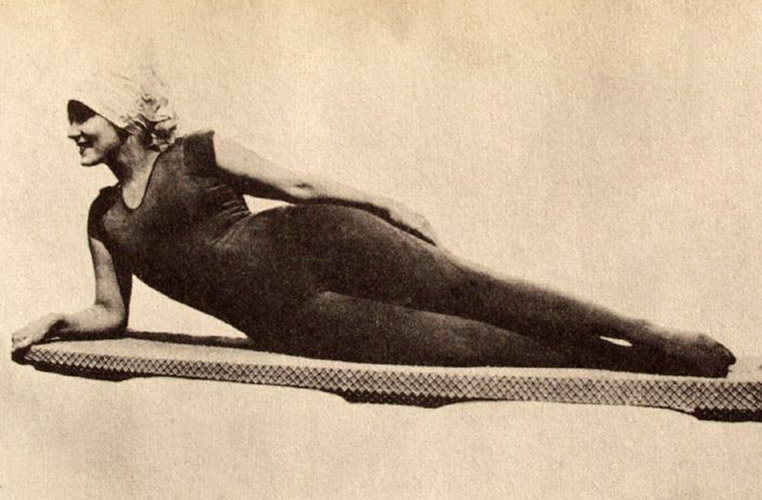While July 5th, 1946 marks the “traditionally” recognized 74th birthday of the bikini, we at TeenyB felt it relevant to dive deep into the history of one of the most scandalous articles of clothing. From Ancient Roman mosaics and satirical paeans to female athletes, appearances of the bikini have been seen throughout the ages. On the silver screen of a post-WW2 America and France, to the modern-day fashion juggernaut in our current decade, the bikini has become iconic in its own right. The history of the bikini is a fascinating look into the Western world’s views on femininity, fashion, modesty, and self-expression have changed throughout humanity.
A “Pre-Modern” Modern Bikini?

While most people associate the bikini, in all its forms, as a contemporary piece of fashion, surprisingly, there exist close analogs to the bikini that date as far back as 5600 BC in what is known as the Copper Age when human civilization began to first settle into large cities. A period that predates Ancient Mesopotamian cultures, Ancient Egypt, and other early recorded histories by several thousand years!
The Mother Goddess and the Bikini
While not resembling a bikini by modern standards, the first instance of this type of clothing appearing was found in the large, ancient Anatolian (modern-day Turkey) city of Çatalhöyük which depicts a mother-goddess figurine wearing a bikini-like article of clothing with two leopard-like creatures on either side. While historians are unsure of the exact significance of the figurine, it has been conjectured that the figurine represents a fertility fetish given its exaggerated feminine features.
Greeks, Romans, and the Bandeau Bikini
Flash forward a few thousand years and the next cultural artifacts that give us a look into “pre-modern” bikinis come from Greek urns that date around 1400 BC and feature women athletes wearing what was called either an apodesmos or mastodeton which is more along the lines of bandeau bikini and acted more as a garment for wearing everyday rather than a bathing suit.
Like the Greeks before them, Roman culture seemed to possess clothing that would pass as a bikini today as seen in a mosaic found in a Sicilian villa that dates back to what historians call the Diocletian Period (286 to 305 AD) that feature women wearing what were called subligar and strophium which acted as bottom and top coverings, respectively.
The mosaic in question features ten women athletes in a variety of poses: from running, lifting weights, and even discus throwing. Perhaps even more interesting is that the mosaic of the “Bikini Girls” features an image of the Roman goddess of love, Eros, which historians gather to mean either the association between “skimpy” clothing, modesty, and femininity or the villa owner’s tastes.
Evidence of similar fashions and the clothing’s affinity to love and relationships were found all over Roman society, from statues of Eros wearing a bikini found in Pompeii, called “Venus in a bikini” to the classic Roman poet Ovid writing that the strophium would be a great place to hide love-letters from secret admirers.
It’s an interesting similarity in thinking to reconcile with between the goddess figurine found in Anatolia and the Roman mosaics and statues given the thousands of years that passed between the two cultures and just goes to show how even when things change, they still stay the same.
As time passed and the Roman Empire began to falter and give way to the Dark Ages and subsequent rise of various European states, the “pre-modern” bikini seems to have gone with it. Bathing and swimming were thought to spread disease and were highly discouraged, thus the need for such items was no longer needed or relevant in Medieval societies. It was not until the 18th century when humanity began to start wearing specific clothing for swimming and bathing.
The Turn of the Century

Unlike Greek or Roman standards of modesty, women’s swimwear around the early 20th century was not anything close to a bikini but rather was something close to a full sleeve, ankle-length chemise, and was called a bathing gown which was made from wool or flannel. This was due in part to societal mores around modesty and “decency”.
Women’s Swim Wear in the Jazz Age
It wasn’t until 1907 that a great leap forward occurred when Australian performer Annette Kellerman was arrested in Boston for wearing a sleeveless, form-fitting one-piece swimsuit that reached from her neck to her feet. From the decade between 1910 to 1920, there was much cultural discourse on the question of swimming as a feminine activity and what exactly that activity would look like.
Much discussion occurred around the functionality of women’s “swimming suits” (which we would be considered modern-day swimwear) and what was called “women’s bathing suits” (which could be thought as attire that met the societal standards of women’s decency while still allowing women to dress appropriately at the beach).
Chic fashion magazines such as Vogue and Harper’s Bazar dedicated sections of their magazines to this issue, the various styles, and opinions on the matter. The June 1, 1917 issue of Vogue reported that there were two kinds of bathing suits: a loose straight suit and those on surplice lines, “... which hold their place by virtue of being so very becoming.”
However, just two weeks later, in the June 15th edition, the magazine made an addendum to this statement, stating a third style of women’s swimwear, a knotted jersey suit, existed (but provided no illustrations) and was described as “... usually sleeveless, quite short and fairly straight ...” and “... intended for the woman who swims expertly.”
However, in the end, societal mores moved more quickly than institutions and by the end of the 1920s, women’s bathing suits moved away from their more functional swimming and more towards decorative and revealing (for the time) cuts that became known as “sun-suits”.
Sun Suits, the Silver Screen, and Cultural Acceptance
As societal norms in the late 1920s and 30s surrounding women’s bodies and bathing suits began to relax, one-piece bathing suits began to having plunging backlines alongside disappearing sleeves, and the creation of latex and nylon allowed fashion houses to develop swimsuits that began to closely hug the body and shoulder straps.
The emergence of two-piece bathing suits, called “sun suits” began, exposing the midriff, and somewhat began to resemble sport bikini tops. In addition to changes in women’s fashion, the silver screen played a big part in furthering the mainstream acceptance of sun-suits.

The actress Dolores del Rio holds the title of the first major star to wear a two-piece swimsuit on screen in the 1933 film Flying Down to Rio. Other films such as Fashions of 1934 features items similar to modern bikinis and The Hurricane (1937) also showcased this new style of swimwear.
Unfortunately, as the United States entered WW2 in 1942, the massive manufacturing power of the country was levied. Due to the war effort, fabric rationing was introduced and a 10% reduction in fabric used for women’s swimsuits was issued by the US War Production Board with Regulation L-85.
The Post-WW2 Effect
Paradoxically, Regulation L-85 led to women’s bathing suits losing their more decorative designs like frills and, in effect, began to reveal more skin.

In the 1930s, two-piece bathing suits that exposed the midriff were worn in films by Hollywood stars of the day like Lana Turner, Ava Gardner, and Rita Hayworth and dominated the silver screen like the 1949 film Neptune’s Daughter.
The continued prevalence of the midriff swimsuit found widespread acceptance with various styles such as the “Beau Catcher” could be found in teen magazines of the 1940s and 1950s, yet it was still considered to only be appropriate for beaches and informal gatherings.
As more and more swimwear designs exploded onto the fashion scene, these new designs tried to address the perennial topics and issues about sizing and fits, but by the 1950s, Vogue infamously declared that the swimwear had become “a state of dress, not undress”.
The Modern Bikini Makes Its Debut
While the one-piece swimsuits and midriff styles were still fashion of the day, the modern bikini aesthetic and design is the result of two different Frenchmen; Jacques Heim and Louis Réard. The modern bikini can trace its origins directly to these two men, but perhaps even more interesting, is that they worked separately yet their designs single-handedly revolutionized women’s swimwear.
Jacques Heim was a fashion designer whose Cannes beach shop introduced a minimalist designed bikini, named “Atome”, in 1946 and the bikini bottom was just large enough to cover one’s navel.
Meanwhile, Louis Réard was an automotive engineer by trade but helped run his mother’s lingerie shop. Inspired after noticing women on the Saint Tropez beach roll the edges of their swimsuits to achieve a better tan, Réard trimmed even more fabric from the bikini bottom (exposing the wearer’s navel) and was made of only 30 square inches of fabric!
Wanting to display his new swimwear with the world, Réard sought to hold a press conference, however, no models outside of 18-year-old Micheline Bernardini would model his bikini due to its salacious nature, but on July 5th, 1949 (five days after the first atomic bomb testing off the Bikini Atoll) Réard debuted the bikini to a stunned crowd.
While Heim’s design was first worn, it was Réard’s name that stuck. Both Heim and Réard engaged in a vicious ad campaign, hiring skywriters with that vied for supremacy. Réard even went as far as saying in an ad campaign that the two-piece swimsuits at the time weren’t genuine bikinis unless they were able to “pass through a wedding ring”.
While the modern bikini had arrived, like women’s swimwear before it during the 1920s, the article of clothing received its fair share of detractors, controversy, and societal resistance.
Bikini Backlash (Once Again)
The modern bikini faced more significant backlash than its earlier predecessors, due in part to continual patriarchal attitudes regarding women’s bodily autonomy. But more surprising is that the modern bikini was so forward-thinking that the consuming public did not know what to make of it and early sales indicated that. It was not until the later parts of the 1950s when societal attitudes surrounding the bikini began to shift.
The modern bikini’s early history was marred by multiple controversies; from banning it outright in select French beaches as well as countries like Italy, Spain, and Belgium, to Catholic Pope Pius XII declaring it sinful after Swedish Miss World winner Kiki Håkansson was crowned the winner in a bikini in 1951. The bikini was subsequently banned from future Miss World competitions. The bikini was even derided by fashion designers, women’s magazines, and actresses alike; swimsuit mogul Fred Cole derided the bikini, German women’s magazine The Modern Girl wrote "It is unthinkable that a decent girl with tact would ever wear such a thing” and even silver screen starlet Ester Williams commented that “a bikini is a thoughtless act”.
Even with more significant pushback than previous iterations of women’s swimwear, the bikini, like two-piece swimsuits from the 1930s, found a home in the silver screen and were worn by actresses of the day, Marilyn Monroe, Betty Gamble, and Brigitte Bardot, who used the bikini as a prop to further their movie careers.
However, no one can be given as much credit to changing societal norms regarding the bikini than Brigitte Bardot did during the 1950s.
Bardot, the Bikini, & Beyond the 1950s

Brigitte Bardot almost single-handedly popularized and garnered the bikini more mainstream acceptance throughout the earlier part of the 1950s when bikini backlash was at its height. Through her appearances sporting the bikini in the 1952 French film Manina, the Girl in the Bikini, and wearing the bikini throughout the 1953 Cannes Film Festival, Bardot gave the bikini an air of sophistication and class.
However, as the 1950s gave way to the sexual revolution of the 1960s, appearances of the bikini became much more prevalent as women began to exert their bodily autonomy through fashion choices and the television, movies, songs, and pop-culture ephemera of the time began to reflect this greater shift in attitude regarding the bikini.
One of the most notable pop-culture pieces which ignited a surge of bikini purchases was the 1960 novelty song by Brian Hyland “Itsy Bitsy Teenie Weenie Yellow Polka Dot Bikini”, which went on to achieve worldwide success, selling one million physical copies, and shot to the top of the Billboard Hot 100.
Alongside the novelty songs of the time, movies, like those in the 30s acted as the main cultural vehicle that allowed greater cultural acceptance of the bikini. In the wake of the infamous bikini scene from the James Bond film Dr. No (1962) when actress Ursula Andress emerges from the sea in a white bikini, swathes of surf movies such as Bikini Beach (1964) and Beach Blanket Bingo (1965) followed and continued to propel the bikini to the forefront of Western countries.
Magazines began to display bikinis in great prominence, as Playboy featured a bikini on its cover in 1962, and just two years later Sports Illustrated debuted its very first swimsuit issue with German model Babette March on the front cover sporting a white bikini echoing Andress’s Dr. No scene.
While magazines played an important role in gaining more widespread visibility, another infamous bikini scene that proved to be another cultural watershed moment was Raquel Welch’s fur bikini in the 1966 adventure-fantasy movie One Million Years BC which was later turned into a poster and turned the actress into a household name.
The bikini had truly arrived by the end of the 1960s with Time Magazine writing that “sixty-five percent of the "young set" is already wearing the itsy-bitsy, teeny-weeny outfits”. After nearly 40 years of back and forth of gradual introduction, societal backlash, to societal acceptance, women’s swimwear, and by extension the bikini, finally achieved wide support across the cultural mainstream by the end of the 1960s.
Since then, the bikini has continued to be further revolutionized as new styles have emerged from Brazilian bikinis, thongs, micro bikinis, and beyond as cultural attitudes around femininity, self-expression, and modesty have evolved. While existing in one form or another from pre-recorded history to the modern era, what is certain is that the history of the bikini has impacted and shaped the cultures that it exists within; from its artistic expressions like sculpture and paintings to its written works, songs, cultural and social attitudes. Time will only tell how the bikini will continue to do so.